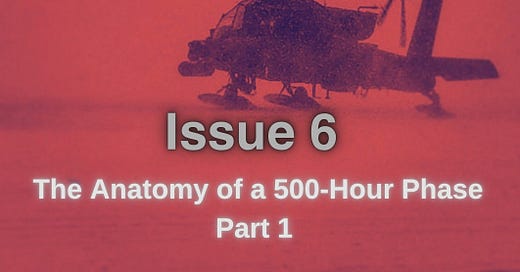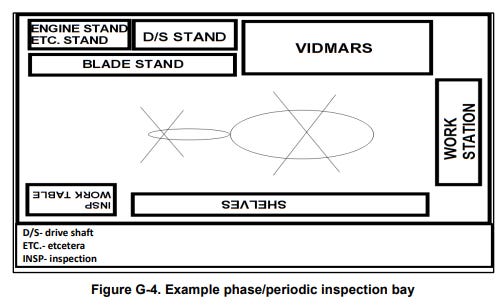This is the first of a multi-part article where we delve in to the intricacies of the most invasive inspection on the AH-64, the 500-hour phase. It is the unit’s time to get deeply involved with repairs of the aircraft. It is crucial that the necessary time and preparation be spent executing it correctly because it is a direct contributor to the Commander’s ability to generate aviation combat power. In this article, we are going to go over the most critical part of a 500-hour inspection, the “pre-phase”. While the 500-hour is applicable to the AH-64, several of the points and themes apply to all major aviation projects / phases.
Pre-Phase
Pre-Phase describes the planning and preparation done prior to aircraft induction. It is a joint effort between PC, QC, maintenance company Command, aircraft owning company Command, the phase team leader, and the phase team itself. Referring to the last article, the bank time flowchart will tell you which aircraft is coming up for phase. As the time nears for an aircraft to enter phase, the production control officer or NCOIC will notify the maintenance company to start preparing for a 500-hour phase. They should give an estimated induction date (coordinated with the aircraft owning unit) and discuss whether the aircraft owning unit can provide a crew chief to assist the phase team (the line company providing a crew chief for the duration of phase is OPTIONAL and not mandatory per ATP 3-04.7).
If not already identified, the maintenance company Command team will identify the phase team leader. ATP 3-04.7 states that the Command will identify the entire phase team, but I usually see the phase team leader get identified and tasked with selecting his or her team members. At this point, the phase team leader can begin the planning process and prepare the phase brief. The phase brief should be prepared in the P4T3 format to most efficiently prepare for the 500-hour phase. Let’s go over some of the major planning points to visit during pre-phase.
Team Selection
Selection of the phase team members can make or break your phase goals. You will want to select a mix of experienced and novice maintainers. The aircraft is broken down into several sections and, in a perfect world, you would want one experienced maintainer working with one novice maintainer in each aircraft section. Unfortunately, manning constraints often limit this ability. Still, do your best to get a mix of experience levels. While you are striving to meet a goal, you should also be using the phase as a training event to advance the experience levels of your maintainers, increasing the Commander’s maintenance production capabilities in the long run.
Maintenance Goals
ATP-3-04.7 dictates the maintenance goal in working days for the AH-64D/E is 44 days. This specifies working days, so you don’t count weekends, holidays, DONSA’s, etc. While time sets the overarching goal for completion, you also need to focus on what needs to be completed under that timeline. The phase team leader, or one of their team members, will want to identify and deferred maintenance, Time Before Overhaul (TBO) parts due within 100 flight hours, safety message compliance requirements (coordinate with your QC shop). If your unit has identified maintenance trends over any length of time, you can also use that data to help predict some issues you may run into. As you gather this information, begin identifying and ordering parts as soon as possible. If there’s any major maintenance that can be completed during the 500-hour phase that will save you downtime down the road, find a way to execute it and plan accordingly.
Phase Maintenance Bay
The design and setup of a phase maintenance bay directly contributes to the efficiency of your team. For example, it is ideal to have a single point of entry and exit for the maintenance bay. This prevents wanderers from crowding your maintenance area and possibly mixing up parts. While logbooks will be carted all around the helicopter, you want to have a centralized location for them to be stored with adequate space for maintainers to sit down and complete write-ups; this can also double as your update location where the section leaders can update you on the progress of their section. Work with your supply rep or S4 to acquire necessary tables, racks, cabinets for parts storage. Each section should have an assigned area to store their parts and hardware. Find a convenient location to maintain a whiteboard so you can internally track section goals and progress and list priorities for each working day. The phase maintenance bay will be your home for the next couple of months, so take the time to deliberately organize it in a way the maximizes every step your team takes during the day, saving them time and energy.
Phase Schedule
While the 44 workday gives us our completion goal, you will want to set milestone markers and select certain days to accomplish certain inspections. While remembering to maintain an adaptable schedule, try to combine major muscle movements when possible. There is an entire series of inspections that involves the aircraft being on jacks. Plan to have all those inspections done on the same day, and not until all major components have been removed from the aircraft. This allows the aircraft to only have to go on jacks once, and while those inspections are being completed, team members from other sections can start off-aircraft inspections. Some basic milestones you can place on the calendar are the expected induction date, expected tear down completion date, expected inspections complete date, expected post-phase MOC date, expected post-phase MTF date, and the expected return to unit date. All these milestones should be flexible, but the closer you remain to those dates, the better.
Phase Brief
At some point, the phase team leader will be expected to give a phase brief in which they outline the phase goals and the plan to attain those goals. While I am personally adamant that a phase brief can be done in a memorandum format, 99% of units will want a PowerPoint presentation. This is likely because of the high turnover of unit personnel and Command wanting to see you present it in person to gain confidence in your preparedness. ATP 3-04.7 gives you an outline of who it expects at your phase brief, but I can tell you from personal experience the most vital members are the Battalion and Company Commanders of the owning unit and the unit completing the phase, a representative, from PC, a representative from QC, the assigned MTP, the back shops platoon sergeant, and the entire phase team. The aforementioned ATP is a good starting point, but your SOP may state something different. Likely, there will be more people than necessary during your phase brief.
Prepare your PowerPoint presentation with a slide to cover each theme from the P4T3. In addition, have a slide that talks about risks; inform the Commanders about not only risks of injury, but also the risk of pulling phase team members from maintenance for other tasks. Risk is most commonly associated with the physical safety of Soldiers, but there are also risks to timelines and efficiency and Commander’s need to be informed of those.
Wrapping up Pre-Phase
At this point, you should be adequately prepared to begin the 500-hour phase. You should get feedback after your phase brief, and you need to be sure to evaluate the feedback and make changes if necessary. Have your team members catch up on appointments, MEDPROs requirements, and online training requirements as necessary so they can be 100% focused once the phase begins.
As a phase team leader, this is your opportunity to have a direct contribution to the effectiveness of your unit. Like Uncle Ben once said, “with great power, comes great responsibility”. Take that responsibility seriously and evaluate what you can accomplish during the phase that will make your unit more effective. Taking the time to do an effective pre-phase will help your team be successful. Don’t skip the details.
The next post is going to discuss operations during the actual phase; induction, to tear down to inspections. If you have any questions about anything discussed here or anything coming up, please come up on the net and let me know!




